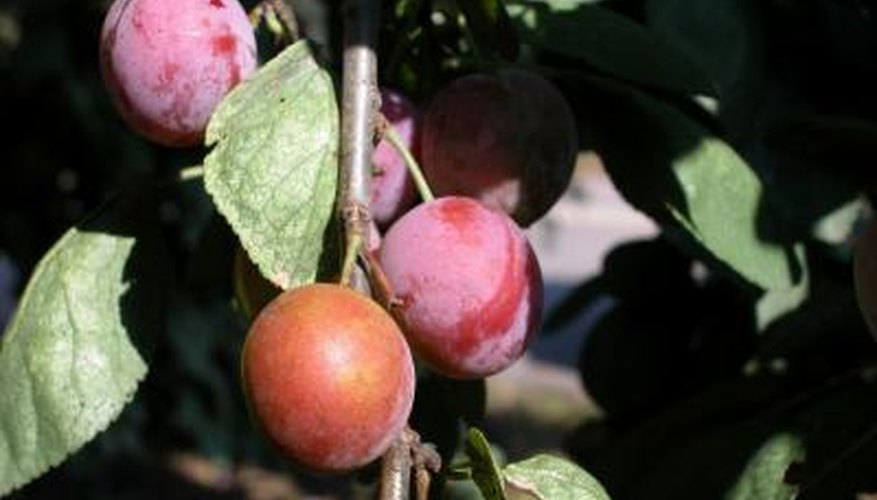The majority of plum fruits sold in North America come from one of two tree species: the European plum (Prunus domestica) and the Japanese plum (Prunus salicina). Cultivators have bred these plum trees specifically for producing fruits, and the branches and twigs of the trees typically do not posses thorns. However, there are a few plum tree species -- specifically the wild varieties -- that do utilise thorns for protecting their fruits.
American Plum
Also known as the wild plum, the American plum (Prunus americanus) is a winter-hardy tree that grows in thickets, or dense groupings of stems and branches. Some of the smaller branches or twigs of American plum trees culminate in sharp thorns, while others -- depending on the season -- display buds, flowers or fruits. According to North Carolina State University, the typical American plum tree blooms with fragrant flowers in early spring and will bear rounded, inch-wide fruits during the middle of summer. While the flowers have white petals with pink centres, the fruits can be either reddish-purple or yellowish-brown. People sometimes use these fruits for making jams and jellies, while wild animals feed on them regularly. Adult American plum trees can reach between 20 and 40 feet in height and form broad, rounded crowns of leaves at their tops.
- Also known as the wild plum, the American plum (Prunus americanus) is a winter-hardy tree that grows in thickets, or dense groupings of stems and branches.
- According to North Carolina State University, the typical American plum tree blooms with fragrant flowers in early spring and will bear rounded, inch-wide fruits during the middle of summer.
Chickasaw Plum
Like the American plum, the Chickasaw plum tree (Prunus angustifolia) grows in thickets, has thorny branches. It produces white flowers and red or yellow fruits. However, the flowers of the Chickasaw plum lack the central pink colouring that is characteristic of American plum flowers; while the fruits are typically smaller with diameters of only 1/2 inch. Also, the leaf tips of Chickasaw plum tree leaves are acute, which means they have rounded sides but end in points. In contrast, the leaf tips of American plum leaves are acuminate, which means they taper to their points and have linear sides. Most Chickasaw plum trees grow to between 6 and 12 feet tall, but some can reach 25 feet.
- Like the American plum, the Chickasaw plum tree (Prunus angustifolia) grows in thickets, has thorny branches.
- Also, the leaf tips of Chickasaw plum tree leaves are acute, which means they have rounded sides but end in points.
Canada Plum
The Canada plum tree (Prunus nigra) is uncommon but does occur naturally over limestone-rich and alluvial soils, according to Natural Resources Canada. An adult tree can reach heights upward of 30 feet, while its small reddish-yellow fruits can grow to be about an inch long. However, many of these fruits fail during development due to fungal infections, leaving behind dried, withered fruit stalks on the Canada plum's branches. Also on the branches of these trees are long thorns, which have dull tips and small buds -- or scars -- running along their lengths.
- The Canada plum tree (Prunus nigra) is uncommon but does occur naturally over limestone-rich and alluvial soils, according to Natural Resources Canada.
- However, many of these fruits fail during development due to fungal infections, leaving behind dried, withered fruit stalks on the Canada plum's branches.
